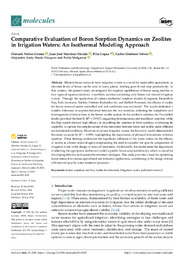Por favor, use este identificador para citar o enlazar este ítem:
https://hdl.handle.net/11000/36672Registro completo de metadatos
| Campo DC | Valor | Lengua/Idioma |
|---|---|---|
| dc.contributor.author | Núñez-Gómez, Dámaris | - |
| dc.contributor.author | Martinez Nicolas, Juan Jose | - |
| dc.contributor.author | Legua, Pilar | - |
| dc.contributor.author | Giménez Valero, Carlos | - |
| dc.contributor.author | Maciá Vázquez, Alejandro Andy | - |
| dc.contributor.author | Melgarejo Moreno, Pablo | - |
| dc.contributor.other | Departamentos de la UMH::Producción Vegetal y Microbiología | es_ES |
| dc.date.accessioned | 2025-05-23T11:23:32Z | - |
| dc.date.available | 2025-05-23T11:23:32Z | - |
| dc.date.created | 2024-05-28 | - |
| dc.identifier.citation | Molecules 2024, 29(11), 2545 | es_ES |
| dc.identifier.issn | 1420-3049 | - |
| dc.identifier.uri | https://hdl.handle.net/11000/36672 | - |
| dc.description.abstract | Efficient boron removal from irrigation waters is crucial for sustainable agriculture, as elevated levels of boron can be toxic to many plants, limiting growth and crop productivity. In this context, the present study investigated the sorption equilibrium of boron using zeolites in two types of aqueous matrices: a synthetic solution containing only boron and natural irrigation waters. Through the application of various isothermal sorption models (Langmuir, Freundlich, Sips, Toth, Jovanovic, Temkin, Dubinin–Radushkevich, and Redlich–Peterson), the efficacy of zeolite for boron removal under controlled and real conditions was evaluated. The results indicated a notable difference in sorption behavior between the two matrices, reflecting the complexity and heterogeneity of interactions in the boron–zeolite system. In the synthetic solution, the Freundlich model provided the best fit (R2 = 0.9917), suggesting heterogeneous and multilayer sorption, while the Sips model showed high efficacy in describing the sorption in both matrices, evidencing its capability to capture the complex nature of the interaction between boron and zeolite under different environmental conditions. However, in natural irrigation waters, the Jovanovic model demonstrated the most accurate fit (R2 = 0.999), highlighting the importance of physical interactions in boron sorption. These findings underscore the significant influence of the water matrix on the efficacy of zeolite as a boron removal agent, emphasizing the need to consider the specific composition of irrigation water in the design of removal treatments. Additionally, the results stress the importance of selecting the appropriate isothermal model to predict boron sorption behavior, which is crucial for developing effective and sustainable treatment strategies. This study provides a basis for optimizing boron removal in various agricultural and industrial applications, contributing to the design of more efficient and specific water treatment processes | es_ES |
| dc.format | application/pdf | es_ES |
| dc.format.extent | 14 | es_ES |
| dc.language.iso | eng | es_ES |
| dc.publisher | MDPI | es_ES |
| dc.rights | info:eu-repo/semantics/openAccess | es_ES |
| dc.rights | Attribution-NonCommercial-NoDerivatives 4.0 Internacional | * |
| dc.rights.uri | http://creativecommons.org/licenses/by-nc-nd/4.0/ | * |
| dc.subject | Boron sorption | es_ES |
| dc.subject | Zeolites | es_ES |
| dc.subject | Isothermal models | es_ES |
| dc.subject | Irrigation water | es_ES |
| dc.subject | Pollutant removal | es_ES |
| dc.title | Comparative Evaluation of Boron Sorption Dynamics on Zeolites in Irrigation Waters: An Isothermal Modeling Approach | es_ES |
| dc.type | info:eu-repo/semantics/article | es_ES |
| dc.relation.publisherversion | https://doi.org/10.3390/molecules29112545 | es_ES |

Ver/Abrir:
molecules-29-02545-v2.pdf
646,33 kB
Adobe PDF
Compartir:
 La licencia se describe como: Atribución-NonComercial-NoDerivada 4.0 Internacional.
La licencia se describe como: Atribución-NonComercial-NoDerivada 4.0 Internacional.
.png)